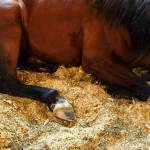Gastrointestinal Glitches: Colic, Ileus Research in Horses

Following colic surgery, horses may suffer post-operative ileus, a life-threatening condition in which the small intestine malfunctions, causing subsequent problems, including the possibility of further surgery. Interestingly, chewing on a bit quickens gastrointestinal transit times, making this an inexpensive, simple, and well-tolerated alternative to a second abdominal surgery.
Veterinarians do not know why horses develop ileus following abdominal surgery. When it occurs, they recommend supportive care or “nonspecific” treatments, such as running intravenous fluids or returning to surgery for decompression. Veterinarians welcome alternatives to better manage affected horses, which would ultimately reduce costs and shorten hospital stays.
“Like horses, humans sometimes develop ileus following abdominal surgery. Chewing gum helps stimulate gastrointestinal reflexes, accelerating time from surgery to first fecal passage. In horses, bit chewing can simulate gum chewing, potentially improving gastrointestinal motility, particularly of the small intestine, following abdominal surgery,” explained Catherine Whitehouse, M.S., of Kentucky Equine Research.
Researchers tested this theory in nine client-owned horses with no history of colic.* All horses fasted for 12 hours before having a nasogastric tube passed into their stomachs to deliver a dose of acetaminophen as well as three self-contained video endoscopy capsules visible on X-ray. Horses were then fasted for an additional 12 hours, mimicking the course of events a horse would be subjected to after colic surgery. Horses then followed a planned refeeding schedule for five days before being fed a diet of free-choice hay.
Blood samples were collected during the first two hours after administering acetaminophen as a measure of gastric-emptying time. Capsules in manure were collected and counted by manual sifting of manure or radiography every three hours until all three capsules passed.
Beginning when the acetaminophen and capsules were administered, horses were fitted with an apple-flavored bit for twenty minutes every six hours until all three capsules were retrieved or until the end of the thirty-day study period. If a horse stopped chewing, then molasses was placed on the bit to encourage additional chewing. For the control, horses were treated identically except for the bit chewing.
Gastric-emptying time, small intestinal transit time, and orocecal transit time were all assessed by movement of the capsules. “Orocecal transit time” is defined as the time it takes to travel from the mouth to the cecum, the segment of the intestinal tract immediately following the small intestine. Gastric-emptying time was also determined by acetaminophen absorption.
All three transit times were shorter in horses permitted to chew bits, but only the slower orocecal transit time reached statistical significance.
“Based on the results of this small study, bit chewing may provide a safe and economical way to manage postoperative ileus in horses recovering from colic and abdominal surgery, though more research is needed,” relayed Whitehouse.
She added, “These case studies highlight the importance of collaboration between veterinarians and nutritionists when advising owners on how to manage and feed horses recovering from colic surgery. Owners and caretakers are encouraged to facilitate these conversations between professionals when pursuing feeding advice for horses with health conditions or special needs.”
For horses experiencing sudden lay-up due to emergency surgery, Kentucky Equine Research recommends supporting bone mineral density by offering Triacton. This product contains a carefully formulated mixture of minerals and vitamins that prevents bone demineralization during stall rest.
*Patton, M.E., F.M. Andrews, S.H. Bogers, D. Wong, H.C. McKenzie III, S.R. Werre, and C.R. Byron. 2023. Effects of bit chewing on gastric emptying, small intestinal transit, and orocecal transit times in clinically normal horses. Animals (Basel) 13(15):2518.








